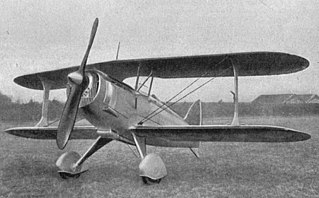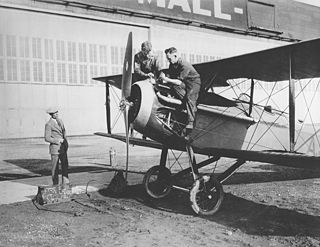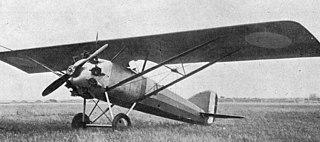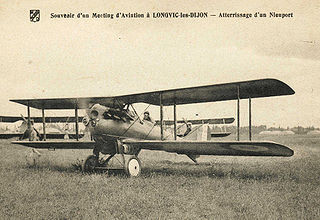
The Dewoitine D.500 was an all-metal, open-cockpit, fixed-undercarriage monoplane fighter aircraft designed and produced by French aircraft manufacturer Dewoitine.

The Blériot SPAD S.510 was a French single-seat, single-engined biplane fighter aircraft. First flying in 1933, 60 were built for the Armée de l'Air, entering service in 1936. The type remained in service as a fighter-trainer at the start of the Second World War. It was the last French biplane fighter to enter production.

The Vought VE-7 "Bluebird" was an early biplane of the United States. First flying in 1917, it was designed as a two-seat trainer for the United States Army, then adopted by the United States Navy as its first fighter aircraft. In 1922, a VE-7 became the first airplane to take off from an American aircraft carrier.

The Curtiss Model N was a military trainer used primarily by the United States Navy during World War I.

The Potez 452 was a French flying boat designed and built by Potez in response to a French Navy specification for a shipboard reconnaissance machine for use on its battleships and cruisers.

The Vickers Vendace was a 1920s British trainer aircraft. It was originally designed as a floatplane trainer for the Royal Air Force.

The Supermarine Sea King was a British amphibious biplane fighter designed and built by the Supermarine Aviation Works in 1920.

The Gourdou-Leseurre GL.30 was a racing aircraft built in France in 1920 which formed the basis for a highly successful family of fighter aircraft based on the same design.

The Heinkel HD 25 was a two-seat shipboard biplane reconnaissance floatplane developed in Germany during the 1920s for production in Japan.
The Heinkel HD 26 was a reconnaissance seaplane developed in Germany during the 1920s for production in Japan. It was intended as a smaller, single-seat counterpart to the HD 25, to provide a spotter aircraft for warships, to take off from a short ramp. The HD 26 was a conventional biplane with staggered wings, twin float undercarriage, and an open cockpit.

The Nieuport-Delage NiD.29 was a French single-seat biplane fighter designed and built by Nieuport-Delage for the French Air Force.
The Handley Page HP.14, also designated Handley Page R/200 was a prototype British naval reconnaissance aircraft of World War I, capable of operating from the decks of the Royal Navy's aircraft carriers or as a floatplane. Only three were built, the Parnall Panther being preferred.

The Potez 39 was a French two-seat single-engined parasol wing monoplane reconnaissance and observation aircraft of the 1930s.
The SPAD XIV was a French biplane floatplane fighter aircraft built by Société Pour L'Aviation et ses Dérivés (SPAD) and flown by the French Navy during World War I.

The Vickers F.B.25 was a British two-seat night fighter prototype of World War I designed to attack enemy airships. Completed in 1917, it failed in its official flight tests that year and no order for production resulted.
The Port Victoria P.V.4 was a prototype two-seat reconnaissance floatplane of the First World War. The P.V.4 was a small single engined pusher biplane. It was unsuccessful as the engine it was designed around was a failure and alternatives were unsuitable, only one aircraft being built.

The Nieuport-Delage NiD 120 series was a series of French single-seat parasol monoplane fighter aircraft of the 1930s. It was built in a number of versions, fitted with various types of engines, with six aircraft designated NiD 123 being sold to Peru.

The Romano R.90 was a prototype single-seat French floatplane fighter of the 1930s. A single example of the R.90 was built, but the type did form the basis of the Romano R.83 and Romano R.92 fighters which were built in secret for the Spanish Republicans during the Spanish Civil War.
The Sage Type 4 was a prototype British floatplane of the First World War. It was a designed as a two-seat reconnaissance aircraft for the Royal Naval Air Service, but was chosen for service as a floatplane trainer, although the end of the war resulted in production being cancelled.
The Hanriot HD.5 was a French two-seat fighter aircraft prototype, built towards the end of World War I. A single-engine biplane with an unusually narrow gap between the upper and lower wings, it did not enter production.
















